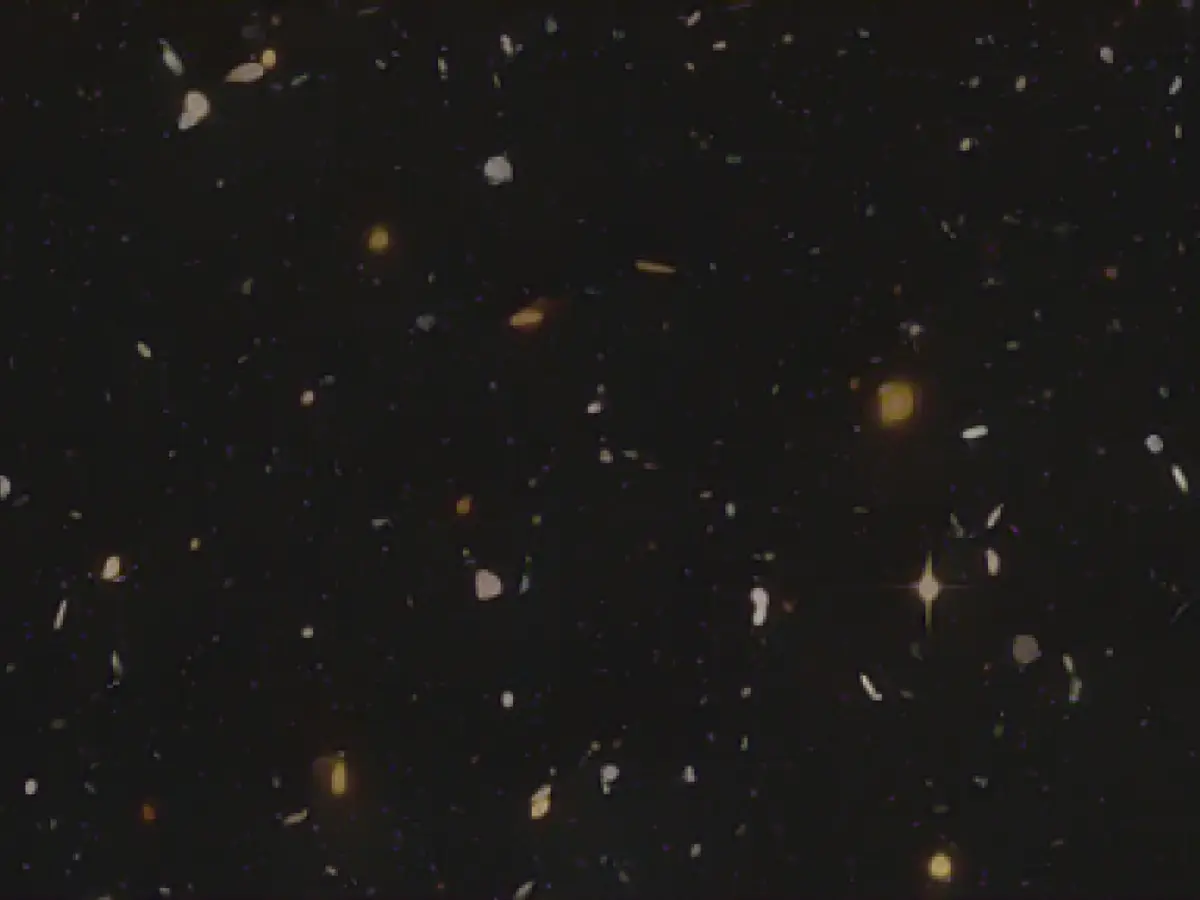Unveiling a Galactic Mystery: Frozen Carbon Monoxide in the Milky Way's Heart
The center of our galaxy, colloquially known as "The Brick" due to its dense and visually opaque appearance, has long puzzled astronomers. Initially, scientists estimated "The Brick" to be roughly 100,000 times the mass of our sun. However, recent observations with the James Webb Space Telescope have contradicted this theory, casting doubt on our understanding of star formation within these dense cloud formations.
What the Webb Space Telescope revealed was far from what astronomers had initially anticipated. Instead of discovering hidden young stars, the telescope's images uncovered that "The Brick" is composed of more than just gas. New studies published in the Astrophysical Journal revealed that "The Brick" is filled with an abundance of frozen carbon monoxide, much more than previously thought[1][2].
The discovery of this celestial frozen treasure trove will have a significant impact on how scientists approach analyzing this region of the Milky Way. The presence of frozen carbon monoxide could drastically alter the methods used to measure and study dark clouds in the galaxy's center.
The what and the why of frozen carbon monoxide
The detection of frozen carbon monoxide in this region is fascinating, but why is it important? Well, for starters, carbon monoxide ices are usually found in areas that are rather cool, typically around 20 Kelvin (-253°C). It's curious that frozen carbon monoxide is found in what appears to be a relatively warm environment, with temperatures around 60 Kelvin (-267°C)[1].
One explanation for this may lie in the fact that dust particles in these clouds are likely to be much colder than their nearby gas. The carbon monoxide could be adhering to these particles as more ice forms around them, or possibly even existing in pockets of water ice containing trapped carbon monoxide.
However, the true reason for this curious finding remains unknown. It's important to understand the mechanisms behind the formation and observed distribution of frozen carbon monoxide in this region of the galaxy, especially as it affects star formation.
Solving several mysteries
The detection of frozen carbon monoxide is crucial in resolving several puzzling issues surrounding the Milky Way's center. Some of these mysteries include:
- What prevents the birth of new stars?: Astronomers have long wondered why they haven't discovered any new stars forming within "The Brick." The abundance of frozen carbon monoxide as well as liquid water may play a role in dissuading this star formation, but further research is required to confirm this theory.
- The structure of "The Brick": Are the "bricks" in this region less dense than previously believed, or is it too early in the birth process for stars to have started forming? More advanced observations could provide answers to these questions.
- Challenges in interpreting data: When interpreting data from the James Webb Space Telescope, there are many challenges to overcome, including calibrating the telescope and understanding its limitations. In this case, the "bricks" appears in images with an odd and different color than what was expected. This reveals potential issues in understanding the true composition of these dense clouds.
The implications of frozen carbon monoxide
The discovery of abundant frozen carbon monoxide has far-reaching implications for researchers studying the Milky Way. This gas can provide valuable insights into the formation and evolution of stars, while also providing crucial data on the presence of water and other necessary elements for life in different parts of the universe.
For example, studies have shown that water reaching the Earth may have originated from comets that collided with our planet. If calculations regarding the cosmological history of frozen carbon monoxide are correct, it could help shed light on the origins and evolution of comets, thereby offering clues about water's origin and distribution across the universe.
The analysis of frozen carbon monoxide could also open up new opportunities to study the formation of complex molecules, like amino acids, which are vital for life.
The role of James Webb Space Telescope
The James Webb Space Telescope is essential for uncovering the secrets and potential of frozen carbon monoxide in the Milky Way's center. Its advanced infrared sensors, which can detect even trace amounts of this gas, provide scientists with the tools they need to study the universe more comprehensively.
In the future, additional telescopes, like the SPHEREx project, will complement the James Webb Space Telescope by surveying larger regions and mapping carbon monoxide and other molecules across the galaxy[1]. The combination of these observational techniques can help researchers better understand the processes of star formation and the distribution of frozen carbon monoxide in various environments.
Final thoughts
The discovery of frozen carbon monoxide in the Milky Way's heart has the potential to shed new light on the formation and characteristics of stars, as well as provide critical clues about the origins of water and other necessary elements for life. Further study of this unique celestial phenomenon with the James Webb Space Telescope and other observational tools will help scientists unravel the mysteries of our cosmic home.

Sources
Enrichment Data Integration:
Carbon monoxide (CO) is a common molecule, which, when frozen, plays a vital role in understanding the composition, formation, and potential for life in dense molecular clouds like "The Brick" in the Milky Way. By detecting the spectral signatures of CO, researchers can infer the presence of other frozen compounds, such as water and volatile species.
The shielding of these ices from cosmic radiation by the cloud's interior suggests that these regions can preserve water and other volatile compounds, which are essential for life. Additionally, the study of frozen CO can help researchers understand the formation of complex molecules, like amino acids, which are vital for life.







